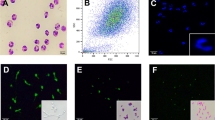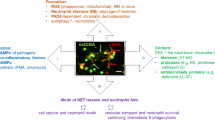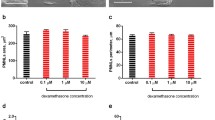Abstract.
Objective and Design: We investigated the in vitro responsiveness of neutrophils adherent to fibronectin (FN) and laminin (LM), toward natural pro-inflammatory and/or phagocyte-activating agents.¶Materials and Methods: Neutrophils from normal volunteers were layered on polystyrene wells precoated or not with FN and/or LM and tested for their ability of responding to eleven pro-inflammatory mediators by evaluation of superoxide anion (O− 2) production and adherence. Results, expressed as mean ± 1 SEM, were evaluated by non-parametric analyses (Mann-Whitney U-test or Kruskal-Wallis non-parametric ANOVA analysis).¶Results: Precoating polystyrene wells with LM or FN prevented the plastic-induced neutrophil O− 2 production. Among eleven agents, tumor necrosis factor-alpha (TNF, 3.0 ± 0.3 nmoles O− 2/5 × 104 neutrophils/180 min, p < 0.001), granulocyte-macrophage colony stimulating factor (GM-CSF, 2.1 ± 0.3 nmoles O− 2/5 × 104 neutrophils/180 min, p < 0.05) and formyl-peptides (fMLP, 2.5 ± 0.5 nmoles O− 2/5 × 104 neutrophils/180 min, p < 0.01) caused massive O− 2 production by neutrophils adherent to FN. None of the mediators was capable of triggering O− 2 production by neutrophils adherent to LM. LM, mixed with FN to coat wells, caused a dose-dependent inhibition of the oxidative burst triggered by TNF (IC50 LM: 0.84 ± 0.03 μg, mean ± 1 SEM), GM-CSF (IC50 LM: 0.36 ± 0.16 μg, mean ± 1 SEM) and fMLP (IC50 LM: 0.54 ± 0.008 μg, mean ± 1 SEM). To the contrary, fMLP (85.5 ± 27.7%), TNF (163.1 ± 67.5%), and GM-CSF (121.8 ± 66.4%) caused a significant augmentation of neutrophil adherence to LM, suggesting that LM-mediated inhibition of neutrophil oxidative metabolism does not depend on the concomitant LM-induced inhibition of neutrophil adherence. Finally, neither solid-phase FN nor LM affected O− 2 production by neutrophils in response to immune complexes.¶Conclusions: Extracellular matrix glycoproteins dictate the response of neutrophils to soluble mediators but not to immune complexes. This appears to be a biologically meaningful mechanism to localise the risk of cellular reactions to mediators that are able to diffuse easily from tissue sites of generation and become widely distributed in body fluids during inflammatory diseases.
Similar content being viewed by others
Author information
Authors and Affiliations
Additional information
Received 2 March 1998; returned for revision 7 May 1998; accepted by M. J. Parnham 27 May 1998
Rights and permissions
About this article
Cite this article
Ottonello, L., Dapino, P., Amelotti, M. et al. Activation of neutrophil respiratory burst by cytokines and chemoattractants. Regulatory role of extracellular matrix glycoproteins. Inflamm. res. 47, 345–350 (1998). https://doi.org/10.1007/s000110050340
Issue Date:
DOI: https://doi.org/10.1007/s000110050340




